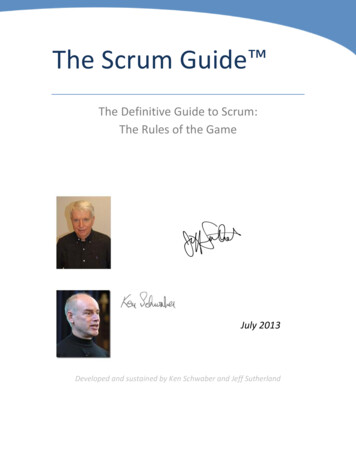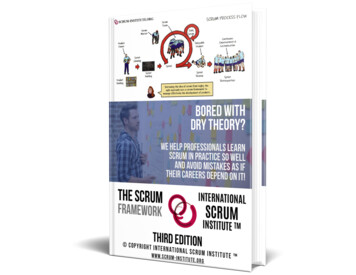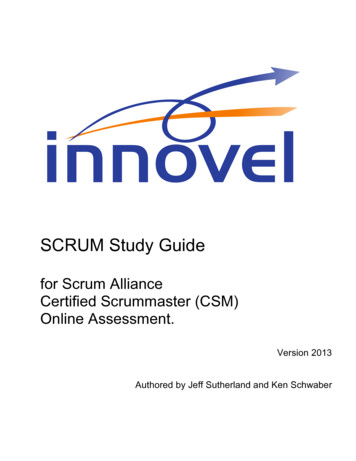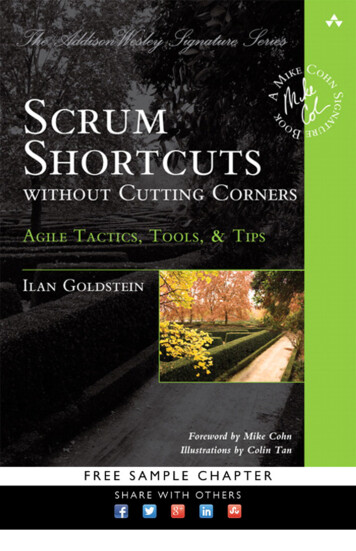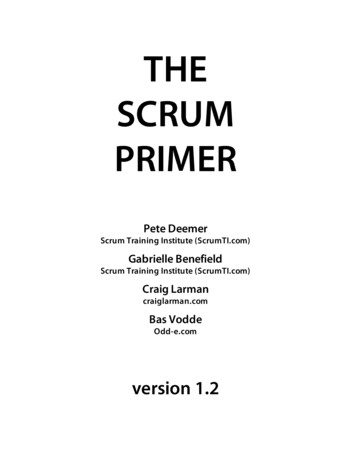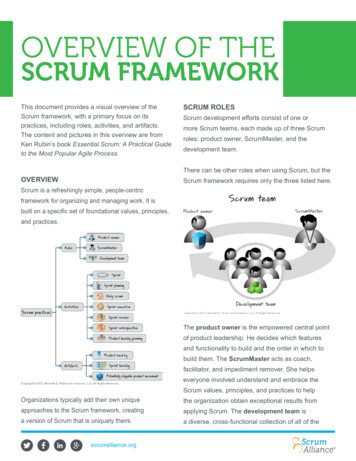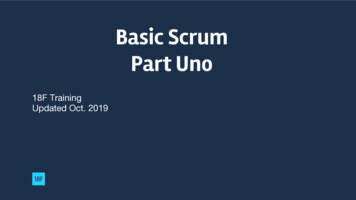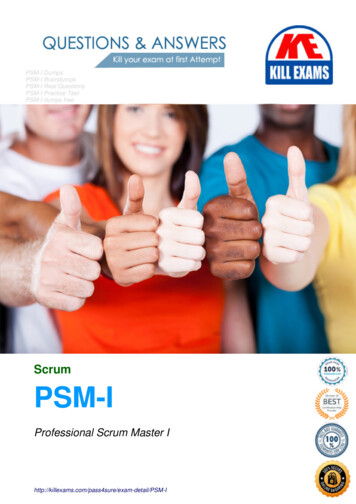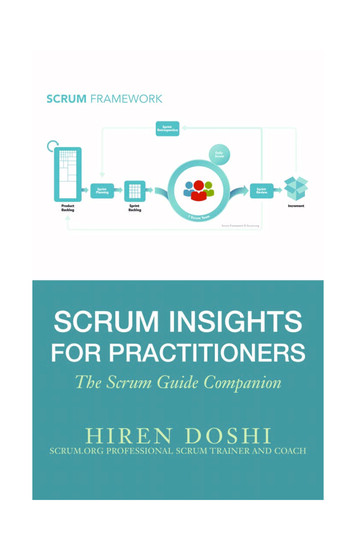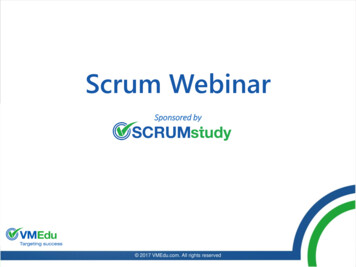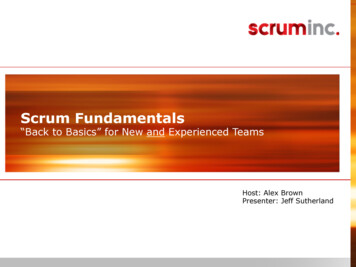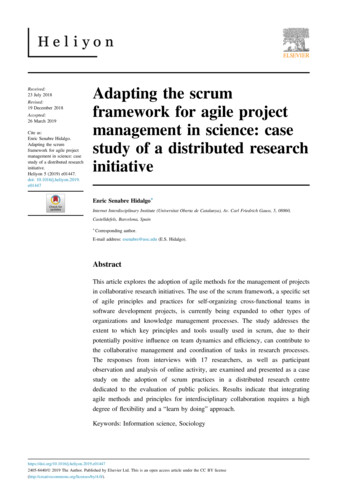
Transcription
Received:23 July 2018Revised:19 December 2018Accepted:26 March 2019Cite as:Enric Senabre Hidalgo.Adapting the scrumframework for agile projectmanagement in science: casestudy of a distributed researchinitiative.Heliyon 5 (2019) e01447.doi: 10.1016/j.heliyon.2019.e01447Adapting the scrumframework for agile projectmanagement in science: casestudy of a distributed researchinitiativeEnric Senabre Hidalgo Internet Interdisciplinary Institute (Universitat Oberta de Catalunya), Av. Carl Friedrich Gauss, 5, 08860,Castelldefels, Barcelona, Spain Corresponding author.E-mail address: esenabre@uoc.edu (E.S. Hidalgo).AbstractThis article explores the adoption of agile methods for the management of projectsin collaborative research initiatives. The use of the scrum framework, a specific setof agile principles and practices for self-organizing cross-functional teams insoftware development projects, is currently being expanded to other types oforganizations and knowledge management processes. The study addresses theextent to which key principles and tools usually used in scrum, due to theirpotentially positive influence on team dynamics and efficiency, can contribute tothe collaborative management and coordination of tasks in research processes.The responses from interviews with 17 researchers, as well as participantobservation and analysis of online activity, are examined and presented as a casestudy on the adoption of scrum practices in a distributed research centrededicated to the evaluation of public policies. Results indicate that integratingagile methods and principles for interdisciplinary collaboration requires a highdegree of flexibility and a “learn by doing” approach.Keywords: Information science, 14472405-8440/Ó 2019 The Author. Published by Elsevier Ltd. This is an open access article under the CC BY /).
Article Nowe014471. Introduction1.1. Team-based collaboration in researchTeam-based collaboration is a critical factor in research organizations and scientificfields, as knowledge is increasingly being generated by research teams (Wuchtyet al., 2007; Wagner et al., 2017). Literature on research practices indicates thatteamwork and collaboration dominate knowledge production in academic organizations and is prevalent in large-scale international research networks (Cooke andHilton, 2015). Academics and investigatory teams working on science, engineeringand social science disciplines have shifted towards collective research (Wuchtyet al., 2007). The benefits of research collaboration range from an increase in citations as a result of the co-authorship of papers to better use of existing resources(Ynalvez and Shrum, 2011). Other benefits include the capacity to generate widersocial impact through large-scale research projects (Bammer, 2008), and more opportunities for knowledge transfer and learning (Lassi and Sonnenwald, 2010) orfor managing complexity (Helbing et al., 2015).The study of collaborative research networks from diverse perspectives has gainedmomentum in recent years (Wang and Hicks, 2015) because funding agencies,which prioritise better use of existing resources, prestige and international reputation, are encouraging large-scale collaborative research programs (Smykla andZippel, 2010). In this respect, research collaboration may be viewed as a selfassembling entity, characterized by fuzzy boundaries and the tendency to functionas networks (Spinuzzi, 2015; Wang and Hicks, 2015) that involve not only differentresearch institutions, but also expand to include collaboration with industry, governments or civil society (Bridgeford and Amant, 2017). Collaboration may occuracross sectors and types of organisations (Bozeman and Corley, 2004), such asgovernment-based research programs, that usually emphasize multidisciplinaryand applied research (Gray et al., 2001), or in industry, where the confines of conducting research are usually bypassed for the sake of academic publishing and thesearch for utility for the non-academic partners (Perkmann and Walsh, 2009).Several authors contend that this shift to research collaboration is occurring amidsta trend towards disruptive adoption of information and communication technologies (ICT) in knowledge-intensive organizations (Jirotka et al., 2013; Borgman,2010; Powell and Snellman, 2004). At present, collective research is undertakenin more distributed, reflexive and less hierarchical work arrangements (Zuboff,1988), thereby expanding the possibilities for complex multidisciplinary and interdisciplinary collaborations on varying scales (K onig et al., 2013). In parallel to theprevailing opinion that research collaboration correlates with high productivity(Daradoumis et al., 2012) and quality results (Rigby and Edler, 2005; 72405-8440/Ó 2019 The Author. Published by Elsevier Ltd. This is an open access article under the CC BY /).
Article Nowe014472011), some scholars describe it as a difficult and ever-changing process, particularly when involving collaboration between geographically dispersed remote teams(Eccles et al., 2009). Key challenges in team-based collaborative research management relate to issues of commitment, transparency or communication and monitoring (Keraminiyage et al., 2009). Collaboration across disciplines also requiresprogressive adaptation of a shared language and different types of tools (Jeffrey,2003).Kraut et al. (1987), describing the process of collaborative research in scientificteams, explain how plans become progressively more detailed and specific, butcan often be revised and even abandoned without negatively impacting collaboration. Other challenges in collaborative research management relate to the need forsupervision and coordination among peers (Delfanti, 2016), or to coordinating anactivity that is continually evolving (K onig et al., 2013). Large-scale research projects usually imply more dedication to leading and coordinating each process, fromresearch design to the collaborative authorship of papers and reports (Bozemanand Corley, 2004). In this sense, collaborative research projects often requirenew project management techniques (Vom Brocke and Lippe, 2015). Methodologically, these additional complexities when performing scientific activities representan evolving interdisciplinary field requiring various types of analysis of how andwhen collaborative research is implemented (Sonnenwald, 2007; Katz and Martin,1997).1.2. Agile project managementAgile project management (APM) or “agile methods” represents a team managementapproach and a productivity framework that supports continuous and incrementalprogress on work priorities, even in the face of changes. APM has its origins inthe agile processes of software development, such as Scrum, XP, DSDM, Cristal,etc., which are programming methodologies based on adaptability to any changeas a means to increase the chances of success of a project (Cohen et al., 2004).Most agile methods try to minimize risks during the execution of a project by developing software in iterations, which usually last from one to four weeks. Each iteration is like a miniature project of the final project, and includes all the tasks necessaryto implement new functionalities: planning, requirements analysis, design, coding,testing, and documentation. An agile programming project aims to release new software at the end of each iteration, and between each iteration the team reevaluates itspriorities.APM has gained in popularity in recent years, primarily in the software industry(Scrum Alliance, 2016) but is progressively breaking into other domains (Ciricet al., 2018). In the late 1990s software development teams started to apply agilemethods for the improvement of programming processes by making them 2405-8440/Ó 2019 The Author. Published by Elsevier Ltd. This is an open access article under the CC BY /).
Article Nowe01447continuous and incremental on the basis of agile principles such as adaptability, personal and group autonomy, modularity and self-organized collaboration, as definedin the Agile manifesto (Beck et al., 2001). The manifesto was a reaction to the weaknesses and rigidity of popular plan-based software production methodologies, suchas the previously highly acclaimed “waterfall” method, which has been criticisedmainly for its lack of responsiveness to change (Cockburn, 2002). APM, more sothan other management frameworks, emphasizes teamwork by focusing on the socialaspects of software development (Rosenberg and Stephens, 2003), channelling cocreation between programmers and other participants in self-organized, cross-functional teams (Hoda et al., 2013), with collective ownership and collective responsibility as key attributes (Robinson and Sharp, 2005). According to Conforto et al.(2014) APM practices include: (1) the use of the “project vision” concept, (2) simplecommunication tools and processes, (3) iterative planning, (4) developing activitiesvia self-managed and self-directed teams, and (5) frequently applying project planmonitoring and updating activities.Despite the critique by some authors that the agile manifesto principles are insufficiently grounded in theory (Conboy and Fitzgerald, 2004) and claims that APMpractices and principles lack focus on software architecture (Rosenberg andStephens, 2003), that it is suitable for small teams but not larger projects (Cohenet al., 2004), and that it is not a panacea for effective project management(Veneziano et al., 2014), the majority of peer-reviewed papers and other empiricalstudies highlight the benefits of adopting agile methods (Dyb a and Dingsøyr,2008). The growing use of APM seems mainly due to the potential for optimizingthe operative capacity of teamwork in short implementation cycles and the positiveinfluence exerted on team dynamics (Fernandez and Fernandez, 2008). Some otherdocumented benefits of the adoption of agile methods relate to the visualization andsharing of progress on tasks, thereby maximizing possibilities for success in projectsin complex and multidisciplinary environments (Cao et al., 2009).As indicated earlier in this discussion, the use of APM has expanded beyond software development to other organizational contexts (Ciric et al., 2018; Rigbyet al., 2016). Analyses have been conducted on the implementation of agile management in product development (Lehnen et al., 2016; Stare, 2014), educational projects(Grimheden, 2013), construction projects (Demir and Theis, 2016), venture capitalgroups (Sutherland and Altman, 2009), innovation processes (Hannola et al.,2013) and the management of projects in libraries (Niemi-Grundstr om, 2014) andbanks (Niclasen and Stoklund, 2016). In parallel to evidence of the contributionof AMP to a more flexible and responsive organizational culture outside of the software development world (K upper, 2016), there is increasingly more academic literature on the adoption of agile methods for different types of collaborative researchprocesses and scientific projects. For example, studies highlight the successful utilisation of APM in academia-industry collaboration (Sandberg and 014472405-8440/Ó 2019 The Author. Published by Elsevier Ltd. This is an open access article under the CC BY /).
Article Nowe014472017; Santos et al., 2016; Ota, 2010); the application of agile methods to facultywork (Pope-Ruark, 2017) and bridging the gap between research and practice inthe management of case studies (Barroca et al., 2015). There is evidence of successin enabling collaboration in working with and mentoring PhD students (Hicks andFoster, 2010); developing prototypes in “Action Design” research projects(Keijzer-Broers and de Reuver, 2016); coordinating a large-scale European researchproject with distributed teams (Marchesi et al., 2007) and for the production of multidisciplinary research reports (Senabre Hidalgo, 2018). APM can also be successfullyused in managing a research and development laboratory (Lima et al., 2012); adopting experimental ethnography approaches in the workplace (Mara et al., 2013); using evidence-based projects for behavioural interventions (Hekler et al., 2016); oradapting lean software development in the biopharmaceutical sector (DeWit,2011) or in human-centred research practices (Armstrong et al., 2015).1.3. The scrum frameworkThe scrum framework is one of the most adapted APM principles and practices (Leiet al., 2017). The scrum methodology facilitates the coordinated activity of programmers who break their work into small tasks that can be completed within fixed duration cycles or “sprints”, tracking progress and re-planning in regular meetings inorder to develop products incrementally. The first reference to the term “scrum” appeared in Nonaka and Takeuchi’s (1995) “The New New Product DevelopmentGame”, where it was defined as a holistic approach to flexible, autonomous and dynamic teamwork with six main characteristics, namely “built-in instability, selforganizing project teams, overlapping development phases, ‘multilearning’, subtlecontrol, and organisational transfer of learning.”In their study on leading technological companies in Japan and in the United States,via interviews with CEOs and engineers about how they developed successful innovative products, the authors identified those key characteristics and defined them asfollows. (1) Built-in instability: when top management offers a project team a widemeasure of freedom and also establishes challenging goals. (2) Self-organizing project teams: when groups take initiatives and develop an independent agenda for theirwork. (3) Overlapping development phases: instead of a sequential approach (wherea project goes through several phases in a step-by-step fashion) the overlappingapproach emphasizes speed and flexibility, and enhances shared responsibility andcooperation. (4) ‘Multilearning’: when team members engage in a continual processof trial and error, “learning by doing” along two dimensions: across multiple levels(individual, group, and institutional) and across diverse functions. (5) Subtle control:although teams can be largely on their own, management establishes checkpoints toprevent instability, ambiguity and tension, while in parallel there’s also controlthrough “peer pressure”. (6) Organisational transfer of learning: participants 14472405-8440/Ó 2019 The Author. Published by Elsevier Ltd. This is an open access article under the CC BY /).
Article Nowe01447their learning to others outside the group, creating conditions for new projects, andalso by assigning key individuals to subsequent projects. Knowledge is also transmitted through the organization by converting project activities to standard practice.Given the focus on a team’s collective intelligence, the scrum framework usually requires facilitation to improve teamwork and motivation, to clarify who’s doing what,to help with conflict resolution techniques, and to ensure that team memberscontribute (Rigby et al., 2016). Like the rest of the team, the facilitator or “ScrumMaster”, who can be an experienced colleague or a professional hired for such purpose, works on a Kanban board, which is used to document the elements, as well asenable the social aspects of tasks (Sharp et al., 2009). The Scrum Master, therefore,performs the role traditionally assumed by a project manager or team leader and, inthis case, is responsible for implementing scrum values and practices, as well asremoving impediments (Cervone, 2011).Subjecting each task to “development sprints” (a period of work averaging 14e20days) is another practice that is directly related to the scrum methodology(Abrahamsson et al., 2017). Sprints, which are iterative cycles where a given projectis developed or enhanced to produce new increments, are usually initiated with aplanning meeting at which participants agree on a list of tasks to be performed bythe end of a specified period. During the sprint, the team meets daily in short meetings called “standups” to track work progress and communicate (Friess, 2018) and, ifnecessary, resolve issues (Marcal et al., 2007). At the end of the sprint, a review or“retrospective” meeting is held at which the team examines developments thatoccurred during the sprint (Marcal et al., 2007). Interested stakeholders may alsoattend this meeting. Another scrum practice that is directly related to the APMframework, in this case derived from Lean production models, involves the small,regular releases of “minimum viable products”, as opposed to final, fully completedand evaluated outputs at the end of long periods (M unch et al., 2013).Whether following the scrum methodology or more “light” and simple aspects of theAPM framework, the adoption of a Kanban board is useful for its practicality and fortracking implementation on a daily basis (Anderson et al., 2012). The literal translation of Kanban, which is of Japanese origin, is “visual” (Kan) “board” (Ban). Using Kanban, work is broken down into tasks, with descriptions shown on cards orPost-It notes that are displayed on a shared board (usually with separate columnsto reflect process). In this way, workflows are visible to all members of the team(Ahmad et al., 2013). Whether via physical or digital tools, the Kanban board infusesthe agile development process with high visibility eproviding a means of displayingthe work assignments of the team, communicating priorities, making it easier tohighlight bottlenecks, and helping to optimize efforts (Cocco et al., 2011). Thiskey aspect of shared visibility and dynamism in the coordination of teamwork daparadigm focused on doable and transparent tasksd is a basic tenet of the 14472405-8440/Ó 2019 The Author. Published by Elsevier Ltd. This is an open access article under the CC BY /).
Article Nowe01447of scrum practices in collaborative processes and organizational structures outside ofthe software development context (West et al., 2010).2. BackgroundAs the previous section argues, agile methods constitute an increasingly popularmanagement process based on principles of adaptive planning, continuous improvement, frequent consultation with participants and small and regular releases (Caoet al., 2009), as well as simplicity and dynamism (Abrahamsson et al., 2017). Inthis paper dan exploratory analysisd the focus is on the appropriation of scrumas a methodological framework and its experimental use in the management ofdistributed and interdisciplinary research initiatives, with the aim of identifyingthe experiences and perceptions of researchers in the adoption of APM principlesand practices, as well as the potential benefits and limitations.In this regard, the paper seeks to answer the following research questions: Which conditions favour the appropriation of APM for research collaboration? To what extent can specific scrum principles and tools be adopted in interdisciplinary contexts? What are the limitations and advantages of adapting agile methods in a distributed research organisation?The UK-based Centre for the Evaluation of Complexity Across the Nexus (CECAN,cecan.ac.uk) is the focus of this case study. CECAN, a research centre hosted by theUniversity of Surrey, was established in 2016 and comprises more than 50 membersworking in 14 different academic organisations such as the University of Warwick,the University of York, Cranfield University and Newcastle University. Conceivedas a network of social scientists, policy makers, policy analysts and experts, CECANexplores, tests and promotes innovative policy evaluation approaches and methodspertaining to food, energy, water and the environment across nexus domains. Theorganisation carries out this mission through the implementation of a series of‘real-life’ case study projects with UK partner institutions including the Economicand Social Research Council (ESRC), the Natural Environment Research Council(NERC), the Department for Environment Food and Rural Affairs (DEFRA), andthe Department for Business, Energy and Industrial Strategy (BEIS), among others.CECAN teams develop case studies and other interdisciplinary initiatives aroundresearch methodologies, complex systems, policy evaluation (in areas related to sustainability or economic promotion), as well as new evaluation and assessmentmethods. As a distributed initiative incorporating experts from diverse knowledgeareas with varying levels of dedication and time capacity for projects, and in theabsence of a central physical office or shared space, it required a specific 14472405-8440/Ó 2019 The Author. Published by Elsevier Ltd. This is an open access article under the CC BY /).
Article Nowe01447to coordination and management. For this purpose, from its early operations, CECAN adopted some APM principles and practices derived from the scrum framework, as well as a digital Kanban board for managing the information andknowledge generated by its teams.3. MethodsThis case study utilised three methodological approaches and data sources: participant observation, analysis of online activity and semi-structured interviews. Thiscombination of approaches forms the basis for the analysis of the adoption of agileprinciples and practices and the scrum framework at CECAN. A six-month period ofparticipant observation of various activities hosted by CECAN resulted in the generation of a database of observation notes. The notes covered team dynamics and references to APM principles and practices in four meetings and two workshops, aswell as the direct experience of facilitating an agile process for a specific projectwith four participants from CECAN. The observation notes and direct experience,together with the parallel literature review on agile principles and the adoption of agile practices in a variety of contexts, served as the basis for the development of thestructure and areas of analytical focus.The statistical and content analysis involved group interactions on the digital Kanbantool Trello (trello.com). Trello, a web-based project management application, is usedas the main channel for coordination and knowledge sharing at CECAN. Data gathered by exporting JSON files and manual scraping of web content from 43 Trelloboards facilitated the understanding of patterns of interaction between levels of activity and types of interaction. More specifically, to observe the correlation betweenthe number of active participants, topics covered on each board and relevant actionson cards (change of status, comments and attachments) were analysed. This providedan overview of relevant interactions as well as active projects related to the centre,and allowed for more detailed coverage of the use of digital Kanban boards, whichwas one of the topics addressed by the interview questions and the data analysis.An interview protocol, designed as the third and main source of data for the study,was used for seventeen semi-structured interviews with researchers (nine men andeight women) from diverse disciplines and institutions who have experience withthe adoption of agile practices in their projects (Table 1). The interview questionswere developed with the goal of obtaining different perspectives on the experiencesof researchers with the use of agile methods for collaboration in their projects. Usingthe semi-structured approach, the interviews took the form of conversations guidedby questions on APM practices, the scrum framework, teamwork and research activity, which naturally evolved through relevant threads of conversation. The participants varied by field, academic background and experience; some were 472405-8440/Ó 2019 The Author. Published by Elsevier Ltd. This is an open access article under the CC BY /).
Article Nowe01447Table 1. Researchers and agile practitioners interviewed.Role of intervieweeInstitutionGenderInvolvementwith CECANScrumMaster roleAssociate ProfessorUniversity of WarwickFemaleYesYesResearch AssociateNewcastle UniversityFemaleYesYesResearch FellowUniversity of WestminsterMaleYesYesResearch AssociateNewcastle UniversityFemaleYesYesResearch DirectorUniversity of SurreyMaleYesNoPostdoctoral ResearcherUniversity of YorkMaleYesYesResearch FellowUniversity of WestminsterFemaleYesYesResearch DirectorNewcastle UniversityMaleYesNoResearch DirectorUniversity of WestminsterMaleYesNoSenior ConsultantRisk SolutionsFemaleYesNoSenior ResearcherTechnical University of DenmarkFemaleNoNoAssociated lecturerOpen University of CataloniaFemaleNoNoResearch ProfessorOpen University of CataloniaMaleNoNoResearcherOpen University of CataloniaMaleNoNoCo-FounderCollaborativeKnowledge FoundationMaleNoNoChief Risk SolutionsMaleNoNocareer while others were mid- to late-career. Ten researchers (RC), from several universities and backgrounds who collaborate with CECAN on regular basis, were interviewed. Among them, six interviewees had the specific role of Scrum Master atCECAN, with responsibility for the coordination of various case studies, on whichother researchers and stakeholders from various institutions collaborate. The remaining seven interviewees (RE) were researchers and practitioners affiliated with institutions outside CECAN, who also had direct experience in the application of agileprinciples, to some extent, in research or academic-related projects. These sevenadditional interviews were conducted in the same period as the other ten, and servedas a control group for contrasting diverse observations and for understanding widelyimportant issues derived from interviews to CECAN members.To capture interview data accurately, each interview (which lasted approximatelyone hour per participant) was audio-recorded and later transcribed for coding. Usinga grounded theory approach, data was coded for emerging themes (Martin andTurner, 1986). Themes were discovered through a recursive coding process, thengrouped into three areas of inquiry related to the research questions (Table 2): (1)conditions for adopting agile methods in research, (2) adoption of scrum practicesand tools, and (3) limitations and advantages of APM adoption in a .e014472405-8440/Ó 2019 The Author. Published by Elsevier Ltd. This is an open access article under the CC BY /).
Article Nowe01447Table 2. Themes derived from interviews in relation to research questions.Areas related to research questionsThemesConditions for adopting agile methods in researchComplex and changing settingCapacity for self-organisationFlexibilityAdaptivityAdoption of scrum practices and toolsFacilitation roles (Scrum Masters)Kanban boardsDevelopment sprintsIncremental developmentChallenges for APM adoption in adistributed research organisationNeed for balanceOffline vs online contextProliferation of kanban boardsTrust in relationshipsTypes of researchTime and resourcesAd hoc adoptionInstitutional cultureresearch organisation. Results were collated into a structured corpus of voicesfollowing that sequence, with the most representative and relevant answers selectedfrom interviewees.The results elaborate the relationship between key principles and practices derivedfrom the literature review on agile methods and principles and reflect the findingsbased on activity and perceptions of participants, while at the same time integratinga description of the basic features of the scrum framework adapted during its experimental adoption.In relation to the interviews conducted for this study, although the method as appliedin this case does not require an ethical committee approval from the author’s institution (Universitat Oberta de Catalunya), all the interviewees volunteered for it andsigned a consent for participation accordingly, guaranteeing that confidentiality as aparticipant will remain secure, and that subsequent uses of records and data will besubject to standard data use policies which protect the anonymity of individuals andinstitutions.4. Results4.1. Conditions for adopting agile methods in researchFrom the observations and interviews conducted with CECAN researchers, from theoutset, it appears that the underlying rationale for selection was premised on key features of the scrum framework and agile methodology such as flexibility, autonomyand yon.2019.e014472405-8440/Ó 2019 The Author. Published by Elsevier Ltd. This is an open access article under the CC BY /).
Article Nowe014474.1.1. Complex and changing settingSince the early operations of CECAN in 2016, its executive board promoted theidea of adopting scrum methods as a possible solution for the self-managementof projects, from case studies or workshop organisation to other publicationoriented initiatives. The complexity of conducting research with groups of stakeholders who operate under existing policies, while also setting an evaluation framework for new ones, demonstrates, as one participant observed, that “unpredictableevents can come along and change the system potentially” (RC1). This need toregularly adapt activity to a complex context, in a new research institution withmore than 30 researchers involved (most of them part-time, a
1.2. Agile project management resentsateammanagement approach and a productivity framework that supports continuous and incremental progress on work priorities, even in the face of changes. APM has its origins in the
